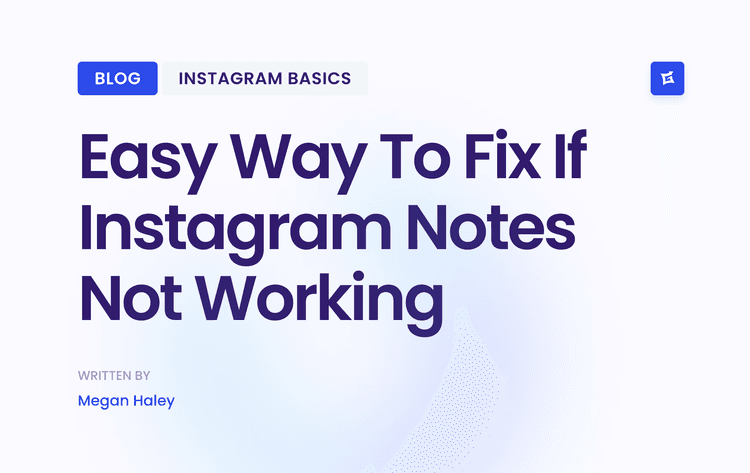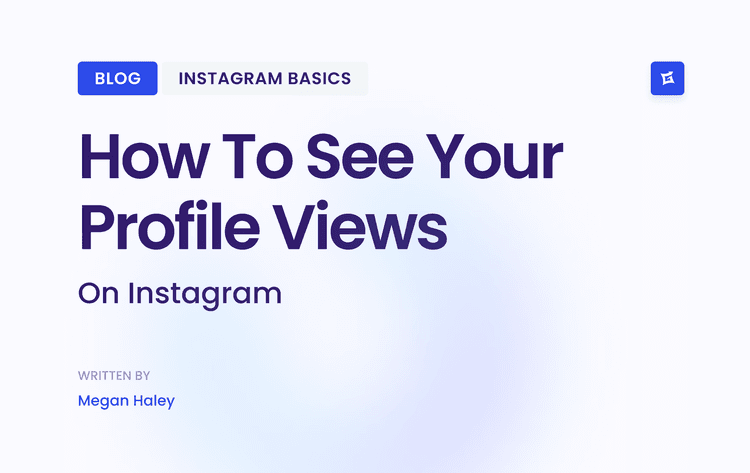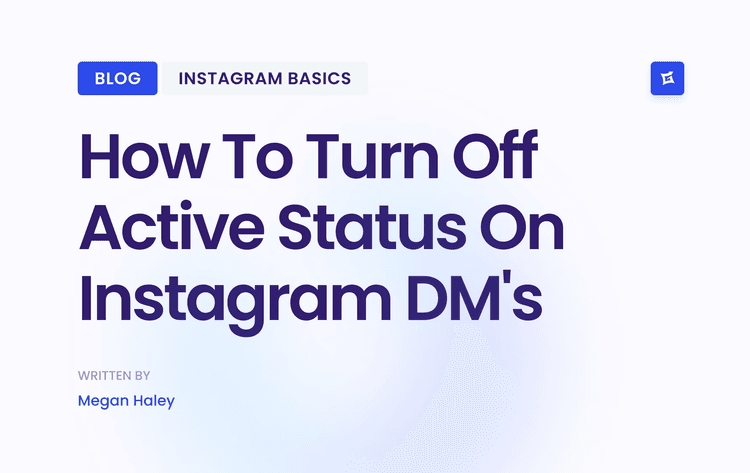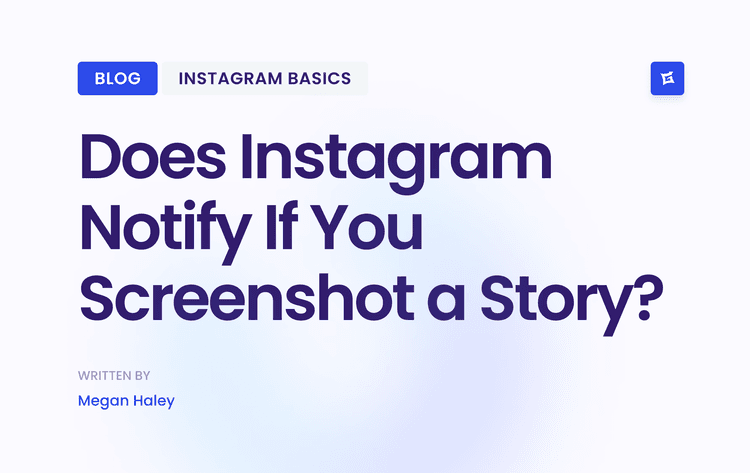What Do Social Media Packages Include?

When you hire a social media manager or agency, you're not just paying someone to post for you. You're investing in strategic thinking, creative execution, and hands-on management, all designed to hit specific business goals. The true value comes from their ability to translate your brand's unique voice into content that genuinely connects with your ideal customers and gets them to take action.
At a bare minimum, any package should cover creating and scheduling content. This keeps your social profiles looking professional and active. However, the real jump in pricing happens when the service moves beyond simple tasks and into the realm of strategy and measurable results.
Core Components of a Standard Package
A solid, mid-tier package goes way beyond just posting. It should weave together several critical functions to create a cohesive social media forum. As you move up in price, the depth and frequency of these services increase.
Here’s what you can generally expect:
Social Media Strategy: This is the blueprint. It involves setting clear goals, figuring out who you're talking to, choosing the right platforms, and creating a content plan that makes sense for your brand.
Content Creation: This is the creative part—writing compelling captions, designing eye-catching graphics or videos, and finding interesting content to share that fits your brand's personality.
Community Management: This is where the magic happens. It's the day-to-day work of talking with your audience—replying to comments, answering DMs, and sparking conversations that build real relationships.
Reporting and Analytics: Any package worth its salt must include performance reports. These should track key metrics like engagement rate, reach, and follower growth so you know what’s working and what’s not.
Beyond these core services, some packages also handle the technical side, like setting up and optimizing your social media tools. For example, knowing the subtle differences when comparing popular bio link tools like Linktree and Carrd can make a huge difference in driving traffic from your profile to your website.
The real difference between a basic package and a premium one isn't just the number of posts. It’s the shift from simply checking off tasks to providing high-level strategic guidance and taking ownership of business outcomes like leads and sales.
To give you a clearer picture, I've put together a quick guide to what you can generally expect at different service levels. Think of this as a starting point to help you figure out where your business needs might fall.
Quick Guide to Social Media Management Service Tiers
Basic (visibility) service tier includes content scheduling, basic graphic design, a monthly performance summary, and the management of 1–2 platforms. The typical monthly price range for this tier is $500 to $1,500.
Standard (Growth) includes all services from the Basic tier, as well as proactive community management, custom content creation, and detailed analytics. The typical monthly price range for this tier is $1,500 to $3,500.
Premium (Partnership) offers all services from the Standard tier, plus full strategic planning, ad campaign management, and advanced ROI reporting. The typical monthly price range for this tier is $3,500 to $5,000 or more.
This list should help you match your budget and goals to the right level of service. As your business grows, you can always move up the ladder to a more comprehensive plan.
Comparing Agency Pricing Models
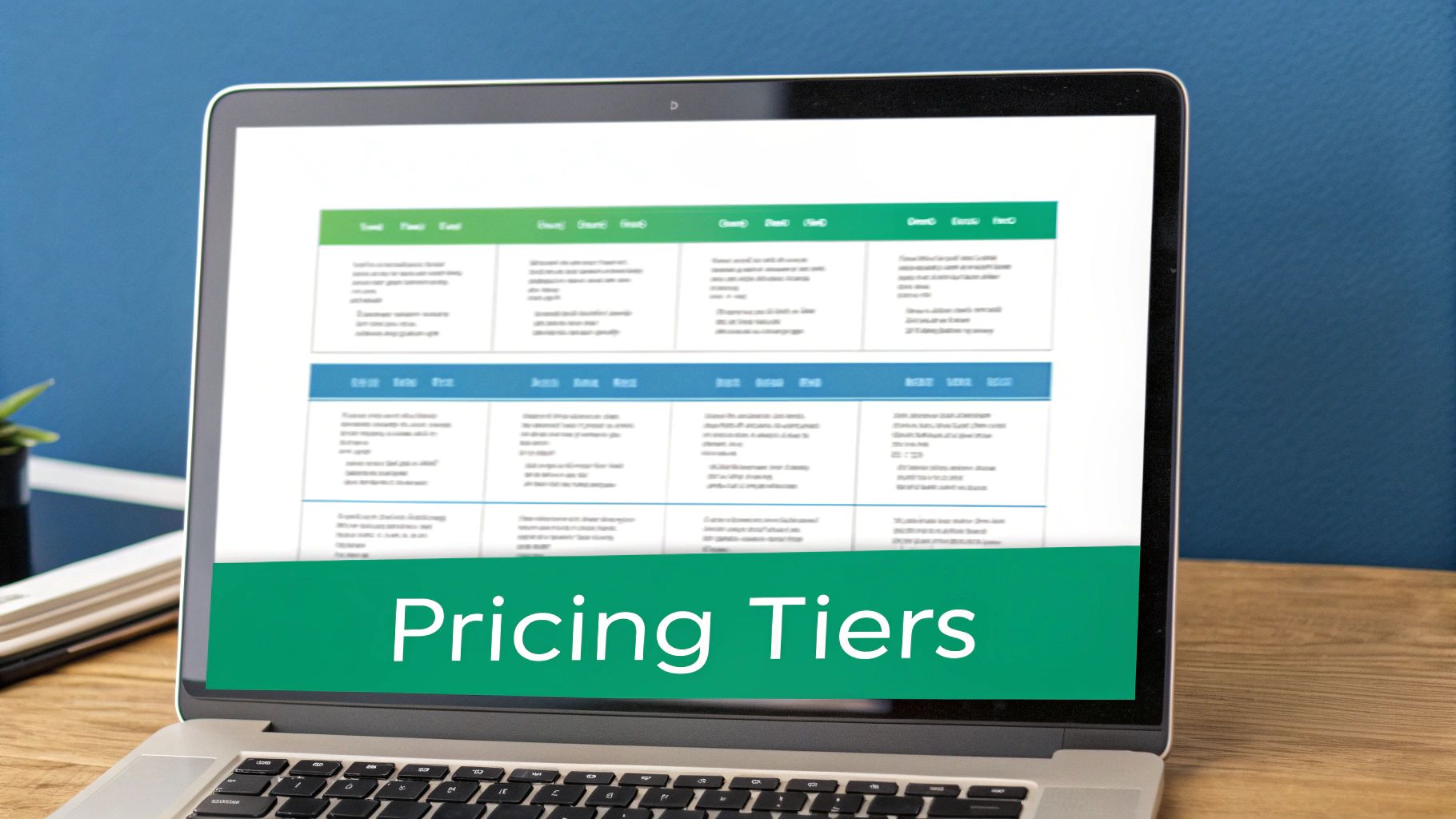
Before you can understand the total cost of any social media package, you need to look past the price tag and see how an agency structures its fees. This pricing model is the foundation of your partnership, shaping everything from your budget's predictability to the agency's core motivation. Choosing the right model is just as crucial as picking the right package.
You'll almost always run into one of four common pricing structures: monthly retainers, project-based fees, hourly rates, or performance-based models. Each one is built for a different purpose and fits certain business goals better than others.
Monthly Retainers for Consistent Growth
The monthly retainer is the bread and butter of the social media management world. You pay a fixed fee every month for a clearly defined set of ongoing services—things like content creation, community management, and monthly reporting. This model is all about playing the long game and building your brand consistently.
Best For: Businesses that need a sustained, always-on social media forum and want to see continuous growth over time.
Scenario: Imagine a B2B tech company aiming to become a thought leader on LinkedIn. A monthly retainer ensures their profile is always active with expert content, that they're engaging in industry discussions, and that their follower count is steadily climbing. It’s all about building momentum.
The biggest win here is predictability. You know exactly what you're spending on social media each month, which makes budgeting a breeze. It also encourages a genuine partnership, turning the agency into an extension of your marketing team.
Project-Based Fees for Defined Outcomes
In sharp contrast, project-based pricing is a one-time, fixed fee for a specific project with a clear start and end date. It's the perfect fit for one-off initiatives where you know exactly what you need done.
This model gives you total cost certainty for a specific outcome. It’s a great option for businesses that aren't quite ready to commit to a long-term contract but need an expert to nail a critical marketing push. For a real-world look at how service providers structure their plans, checking out Cometly's pricing page can give you a feel for different tiers and their associated costs.
Best For: Product launches, event promotions, or a complete social media profile overhaul.
Scenario: A local restaurant is opening a new location in two months. They need a focused campaign to create buzz, run a contest before they open, and pack the house on grand opening night. A project-based fee would cover that entire launch campaign from start to finish.
Hourly and Performance-Based Models
While less common for full-service management, hourly rates often pop up for things like consulting, strategy sessions, or troubleshooting. You simply pay for the exact time an expert spends on your account. It's flexible, sure, but budgeting can be a headache since costs can fluctuate.
A more modern, and frankly more exciting, approach is performance-based pricing. Here, the agency's fee is tied directly to hitting specific, measurable results. This model puts the agency's skin in the game, aligning their success directly with your business goals.
The core differentiator of performance-based pricing is its focus on tangible business outcomes, like generating qualified leads or driving e-commerce sales, rather than just delivering a list of services. It shifts the conversation from "what did you do?" to "what did we achieve?"
This results-first approach is gaining traction because it minimizes your risk as the client. Payment depends on success, making it a compelling option for any business focused squarely on ROI. Just know that it often requires a higher potential payout for the agency to compensate them for taking on that risk.
Ultimately, the scope of work and the level of strategic thinking involved will heavily influence the final price, no matter the model. Basic services for a single platform might start around $500 per month, but a comprehensive strategy with paid advertising can easily run over $5,000 monthly. More and more, agencies are moving toward value-based pricing, where the fee reflects the actual business impact—a trend that proves social media is no longer just a marketing channel, but a core driver of business results.
A Detailed Comparison of Social Media Service Tiers
Choosing a social media package is a big decision. Moving up from a "Basic" to a "Premium" plan isn't just about paying for more posts—it's about shifting your entire approach from simply having an identity to forging a strategic partnership that drives real growth. Let's dig into what you get at each level.
This infographic gives you a quick visual breakdown of how costs and what you get in return scale up.
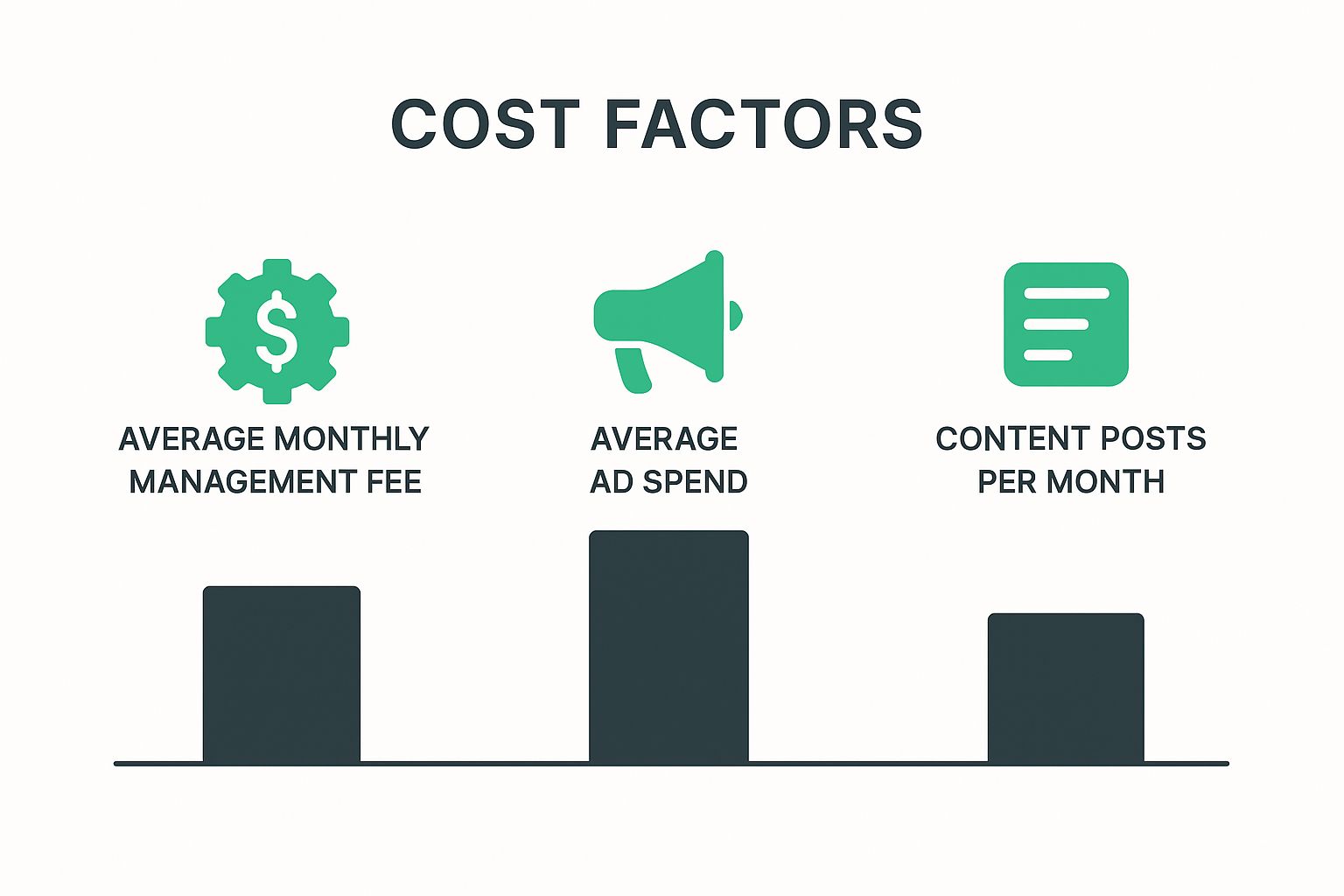
As you can see, the management fees, ad spend, and the sheer volume of content all climb with each tier. This isn't just about more stuff; it reflects a much deeper level of strategic work and the kind of business results you can expect.
Basic Packages: The Foundation of Visibility
A Basic package only has one job: to get your brand online with a professional, consistent visibility. Think of it as laying the foundation. It's the perfect starting point for new businesses or anyone just dipping their toes into social media who wants to make sure their profiles look active and credible.
At this level, the focus is all on maintenance, not aggressive growth.
Content: You'll typically get a fixed number of posts each week on one or two key platforms. The content is usually straightforward—branded graphics, simple captions, and maybe some curated articles.
Engagement: Community management is pretty light. It usually just covers responding to direct comments or simple questions. Proactive outreach isn't part of the deal.
Reporting: Expect a simple, high-level monthly report. It’ll track the basics, like your follower count and engagement rate, but not much deeper.
This tier is a great fit for a local service business, like a plumber or a cafe, that just needs a polished Facebook page to prove they’re open and active. It's about being findable and looking legitimate online, without a heavy investment in complex campaigns.
Standard Packages: The Engine for Growth
This is where things get interesting. A Standard package shifts the focus from just "being there" to actively growing your audience and sparking genuine engagement. This tier is built for businesses that have their foundation set and are ready to invest in building a real community and driving more meaningful results.
The key difference here is the switch from reactive to proactive work.
With a Standard package, you're no longer just maintaining a profile; you're actively cultivating an audience. The goal is to create content that resonates deeply and sparks conversations, turning passive followers into engaged fans.
Here, you'll see a noticeable jump in the quality of content and strategic thinking. Expect higher-quality custom graphics, maybe some light video content, and much more targeted messaging. The community management also gets a boost, with the agency actively looking for conversations to join and engaging with potential customers.
Premium Packages: A Strategic Partnership
A Premium package goes beyond typical social media management—it becomes a true strategic partnership. This top tier is designed for businesses that view social media as a primary channel for generating revenue and are laser-focused on measurable ROI. It's the all-in solution.
At this level, every action is tied directly to a specific business goal.
Strategy: You're not just getting a manager; you're getting a dedicated strategist. They provide deep-dive planning, competitor analysis, and constant optimization.
Advanced Services: This tier almost always includes sophisticated ad campaign management across multiple platforms, complete with A/B testing and detailed sales funnel tracking.
Reporting: Forget vanity metrics. The analytics here are all about the bottom line. You'll get detailed ROI reports that connect social media activities directly to leads, sales, and your customer acquisition cost (CAC).
A great example is an e-commerce brand trying to scale aggressively. They'd go for a Premium package because the agency wouldn't just be posting content. They'd be running complex retargeting ad campaigns, helping optimize landing pages, and delivering reports showing exactly how much revenue was generated from every dollar spent on social.
To make these differences crystal clear, let's put them side-by-side.
Feature and Outcome Comparison Across Service Tiers
This list breaks down what you can realistically expect from each package, moving beyond just features to focus on the actual business outcomes. It helps clarify the jump from a simple "visibility" plan to a full-blown "partnership."
Basic Package (Visibility)
Primary Goal: Helps establish a professional online forum and maintain consistent activity.
Strategic Input: Minimal; follows a basic content calendar without in-depth planning.
Content Creation: Uses standard templates and curated content for 1–2 platforms.
Community Management: Reactive approach, responding only to direct mentions and comments.
Ad Management: Not typically included, or limited to very basic boosted posts.
Reporting: Provides a high-level monthly report focusing on vanity metrics.
Best For: Ideal for new businesses, local shops, or those with very small budgets.
Standard Package (Growth)
Primary Goal: Focuses on growing audience, engagement, and brand awareness.
Strategic Input: Includes monthly strategic planning and development of content themes.
Content Creation: Provides custom graphics and compelling copy for 2–3 platforms.
Community Management: Proactive engagement that initiates conversations and builds community.
Ad Management: Includes basic ad campaigns aimed at generating awareness or traffic.
Reporting: Offers detailed analytics on performance and audience growth.
Best For: Designed for growing businesses ready to invest in community building.
Premium Package (Partnership)
Primary Goal: Aims to drive measurable business results, leads, and sales with a strong focus on ROI.
Strategic Input: Offers deep, ongoing strategic guidance and competitive analysis.
Content Creation: Delivers high-end creative assets, including video content and full campaign materials.
Community Management: Comprehensive relationship management and lead nurturing.
Ad Management: Manages advanced, multi-platform ad campaigns with full-funnel tracking.
Reporting: Provides in-depth ROI reporting that ties social media spend directly to revenue.
Best For: Tailored for e-commerce, B2B companies, and organizations focused on lead generation.
Ultimately, the right package isn't about which one is "best"—it's about which one aligns with your current business goals and resources. Use this comparison to have an informed conversation with any potential agency and ensure you're investing in a plan that will deliver the results you're truly after.
How Social Media Ad Spend Fits Into Your Budget
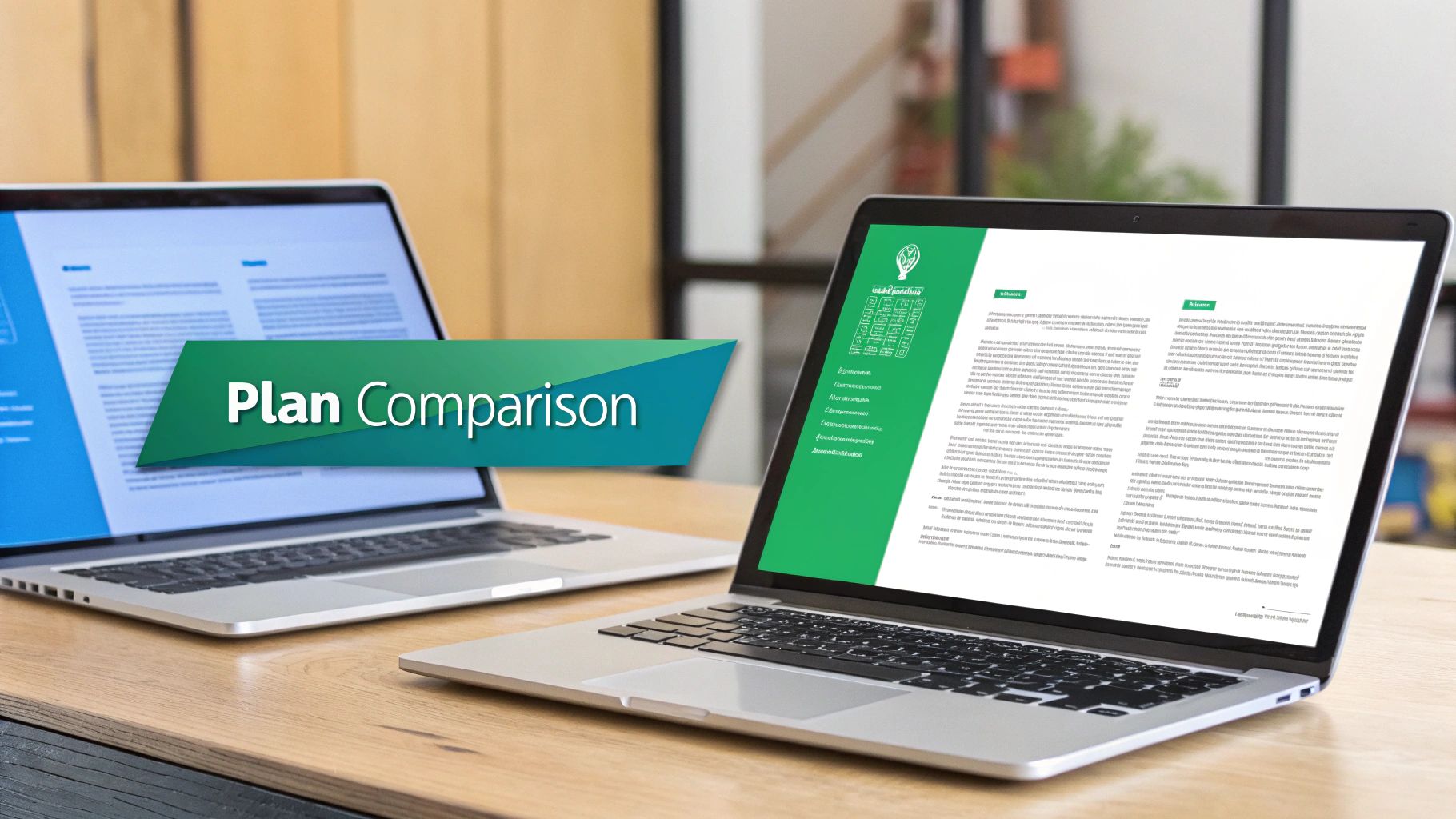
When you start looking at social media packages, one of the first things to get straight is the difference between the management fee and the ad spend. It’s a common point of confusion, but the distinction is simple and vital for planning your budget. The management fee is what you pay an agency or consultant for their strategy, creative work, and campaign execution.
Ad spend is a completely separate line item. This is the money you'll pay directly to platforms like Meta (for Facebook and Instagram), TikTok, or LinkedIn. Think of it as the fuel for your paid campaigns—the cash that gets your content in front of a wider, highly targeted audience. While a premium package will almost certainly include managing this ad spend, the cost of the ads themselves is an additional investment.
Getting a Handle on Key Ad Metrics
To have a productive conversation about your advertising budget, you need to speak the language. A few key metrics tell the story of how your money is being spent and what you’re getting back. The two most fundamental terms you’ll hear are CPM and CPC.
CPM (Cost Per Mille): This is a fancy way of saying "Cost Per Thousand Impressions." It's the price you pay for your ad to be shown 1,000 times. If your main goal is pure brand awareness and getting as many eyeballs on your business as possible, CPM is your go-to metric.
CPC (Cost Per Click): This one’s more straightforward—it's the price you pay every time someone clicks on your ad. CPC is all about performance. It’s the metric that matters most when you're trying to drive traffic to a website, a specific landing page, or a product for sale.
These numbers aren't just jargon; they're the building blocks of an efficient campaign. They help you and your agency figure out which ads are hitting the mark and where to allocate your budget for better results. Tracking them is also essential for measuring your success. For a much deeper look, our guide on calculating social media ROI lays out the whole framework.
Why Ad Costs Are So Different Across Platforms
One of the most common questions is, "Why does it cost so much more to run a campaign on one platform versus another?" The answer comes down to a mix of platform maturity, the kind of audience you're trying to reach, and how many other advertisers are competing for their attention. Every social network runs its unique ad auction, where prices are set by classic supply and demand.
The ad auction is a living, breathing marketplace. Costs are always in flux, influenced by everything from seasonality (prices skyrocket during the holidays) to the number of advertisers targeting the same people you are. A good agency's job is to navigate this constantly shifting environment to squeeze the most value out of your budget.
This variability becomes crystal clear when you look at the numbers. Recent data shows just how much advertising costs can swing. For example, the average cost per thousand impressions (CPM) on Meta's platforms was $8.17, with an average cost per link click (CPLC) of $0.68.
Now, compare that to TikTok, where the CPM was just $2.97. That gap is closing as more advertisers jump on board, but it’s still significant. Meanwhile, Snapchat's CPM jumped by a massive 47% year-over-year to $6.43, a perfect example of how quickly these markets can change.
This data underscores the need for a flexible ad strategy. A budget that gets you incredible reach on TikTok might barely make a dent on a platform like LinkedIn, where you’re paying a premium to target high-value professionals. The right platform for you always comes back to your specific goals and a clear-eyed understanding of where your ad dollars will work the hardest.
How to Choose the Right Social Media Package for Your Business
Now that we've broken down what agencies offer and how they price their services, it's time to connect the dots back to your own business. The best social media package isn't always the most expensive or the one packed with the most features. It's the one that aligns with your specific goals, your audience, and your budget.
To find that perfect fit, you have to shift your thinking from "What do I get?" to "What do I need to achieve?" This starts with an honest look at your business model and objectives. That self-assessment will help you filter through the endless social media packages and pricing models to find something that truly works for you. A local brick-and-mortar shop needs something completely different than a global B2B software company, and that's okay.
Matching Your Business Needs to the Right Package
Let's walk through a few common business scenarios. Seeing how different goals demand different social media investments can help you pinpoint where you fit.
Scenario 1: The Local Community Builder
Think of a neighborhood coffee shop, a boutique fitness studio, or a local bookstore. Their success doesn't hinge on a complex global strategy. The main goal is simple: build a loyal local following, drive foot traffic through the door, and share daily updates that keep them top-of-mind.
Recommended Package: A Basic or a lower-tier Standard package is usually the perfect starting point.
Why It Works: Here, the focus is on consistent engagement on one or two key platforms, like Instagram and Facebook. The package should prioritize authentic, high-quality content and active community management, not overwhelming analytics or big ad campaigns. A simple monthly retainer gives them the budget predictability they need to thrive.
Scenario 2: The E-commerce Sales Driver
An online store selling anything from fashion accessories to the latest tech gadgets has one primary mission: to drive sales. Brand awareness is great, but every social media action must ultimately point toward a transaction.
Recommended Package: A Premium package, possibly with some performance-based pricing mixed in.
Why It Works: This kind of business needs sophisticated ad management, constant A/B testing of creative and copy, and a deep understanding of sales funnels. The agency isn't just a content creator; they're a strategic partner laser-focused on ROI, using detailed reporting to track metrics like customer acquisition cost (CAC). This is critical in a market where global social media ad spending is projected to surpass $200 billion.
Scenario 3: The B2B Authority Leader
For a B2B company like a consulting firm or a SaaS provider, social media is a long game. The goal is to build credibility, generate high-value leads, and establish themselves as the go-to experts in their industry.
Recommended Package: A high-end Standard or Premium package, typically on a monthly retainer.
Why It Works: The strategy is all about thought leadership content, especially on platforms like LinkedIn. The package needs to cover in-depth content creation (think case studies, white papers, and expert interviews), managing the profiles of key executives, and targeted outreach. Because B2B sales cycles can take months, a steady retainer makes the most sense for this long-term approach.
Ultimately, choosing the right package boils down to one question: Are you paying for presence, growth, or direct revenue? Answering that honestly will tell you whether you need a simple content plan or a sophisticated growth engine.
Critical Questions to Ask Any Agency Before You Sign
Before you commit to a contract, you have to do your due diligence. The success of your investment hangs on the agency's real-world expertise, internal processes, and how they communicate. To help you choose wisely, you might find our guide on effective social media growth strategies useful.
Bring this checklist to your discovery calls to dig past the sales pitch:
Industry Experience: "Can you show me case studies or real results from clients in an industry like mine?"
Strategic Process: "Walk me through your process for developing a social media strategy from scratch for a new client."
Reporting and Metrics: "What specific KPIs will you track to measure success for us, and how often will we get performance reports?"
Team and Communication: "Who will be my day-to-day contact, and what's your typical response time for questions or concerns?"
Contract Terms: "What are your standard contract lengths? And what happens if we need to adjust our package or cancel our agreement down the line?"
Asking these direct questions will help you see if an agency has the skills and systems to back up its promises.
Common Questions About Social Media Service Costs
Choosing a social media partner and the right package often feels like navigating a minefield. You've got questions, and you need straight answers before you commit your budget. Let's clear up some of the most common sticking points so you can move forward with confidence.
How do you spot a bad agency?
A major red flag is any agency that guarantees results, like “1,000 new followers in 30 days.” Real growth is organic and unpredictable. Be cautious of extremely low prices, which may indicate corner-cutting, and of agencies that use vague reporting focused on vanity metrics like “likes.” Also, avoid one-size-fits-all strategies. If an agency doesn’t ask thoughtful questions about your business, they’re unlikely to create a plan that genuinely works.What does a fair contract look like?
While many agencies prefer 6- or 12-month commitments, a safer approach is to begin with a 3-month trial period. This allows both parties to evaluate the partnership without a long-term obligation. A confident agency should be willing to prove its value within a shorter time. The contract should clearly define the scope of work, deliverables, payment terms, and the process for either party to end the agreement.How is social media ROI measured?
Real ROI is much more than likes or shares. It links social media activity to tangible business outcomes, such as website traffic, lead generation, and sales conversions. You’ll need tools like analytics platforms and tracked URLs to follow the customer’s journey from a post to a purchase. Using a social media marketing checklist can help ensure your tracking is set up effectively from the start.Are platform costs included?
Typically, no. Most agency fees cover strategy, content creation, and ongoing management. However, ad spend and subscriptions to specific tools or platforms are usually separate. For instance, if your campaign relies on LinkedIn networking, costs like LinkedIn Premium would be an additional line item in your budget. Your agency should clarify these distinctions upfront.
Ultimately, transparency is everything. A trustworthy partner will be open about their process, pricing, and how they measure success, ensuring you always know exactly what you're paying for and what you're getting in return.
Are you ready to grow your Instagram with a strategy that delivers real results? Gainsty uses advanced AI and expert insights to drive organic follower growth and boost engagement, all without bots or fake followers.
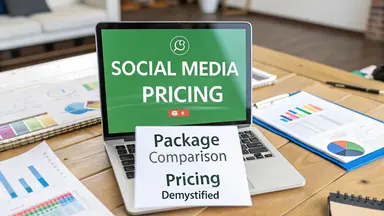
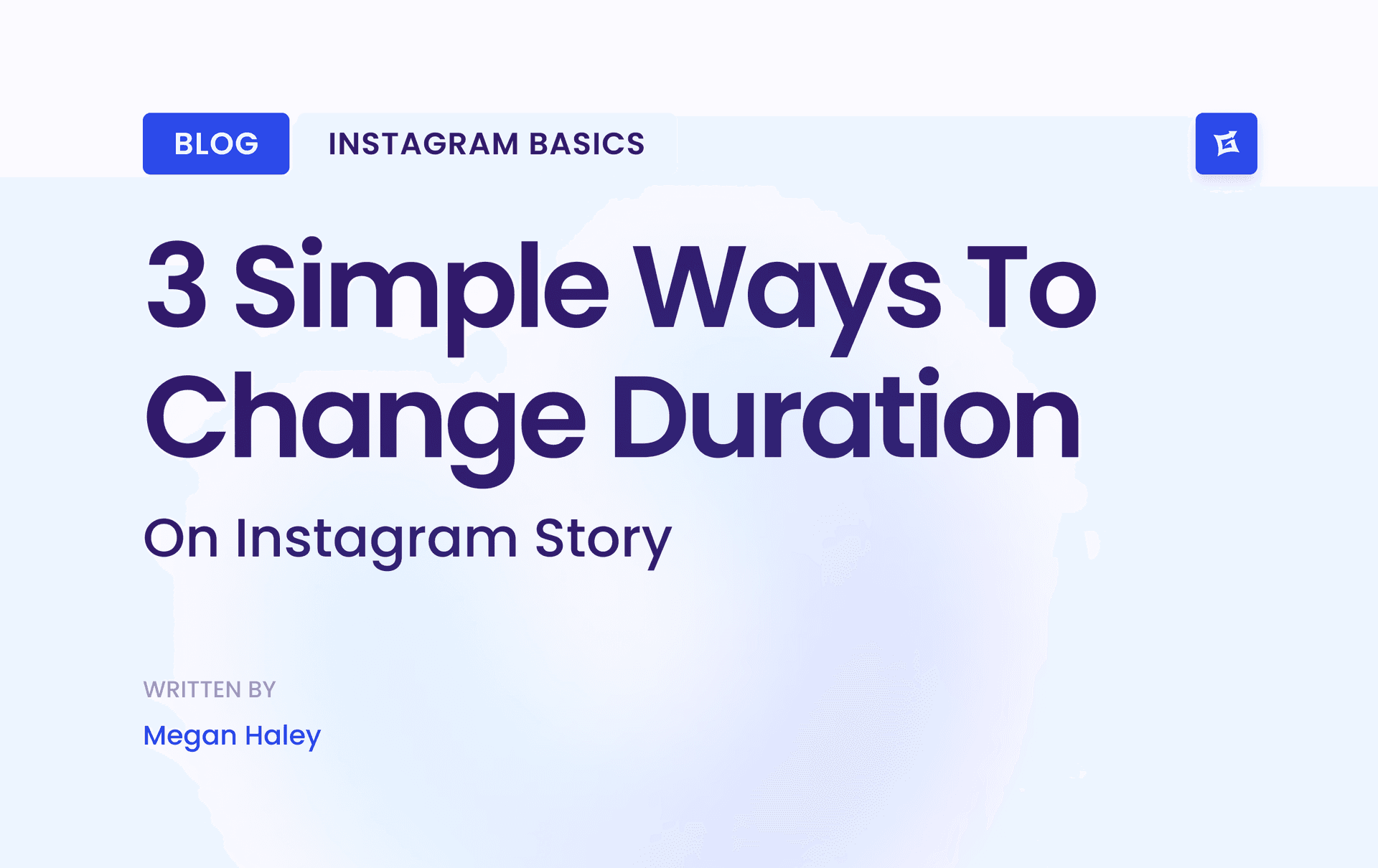
.png&w=1920&q=75&dpl=dpl_9XSWKBjhcBN6v6b1SN7m3p1WWjfr)
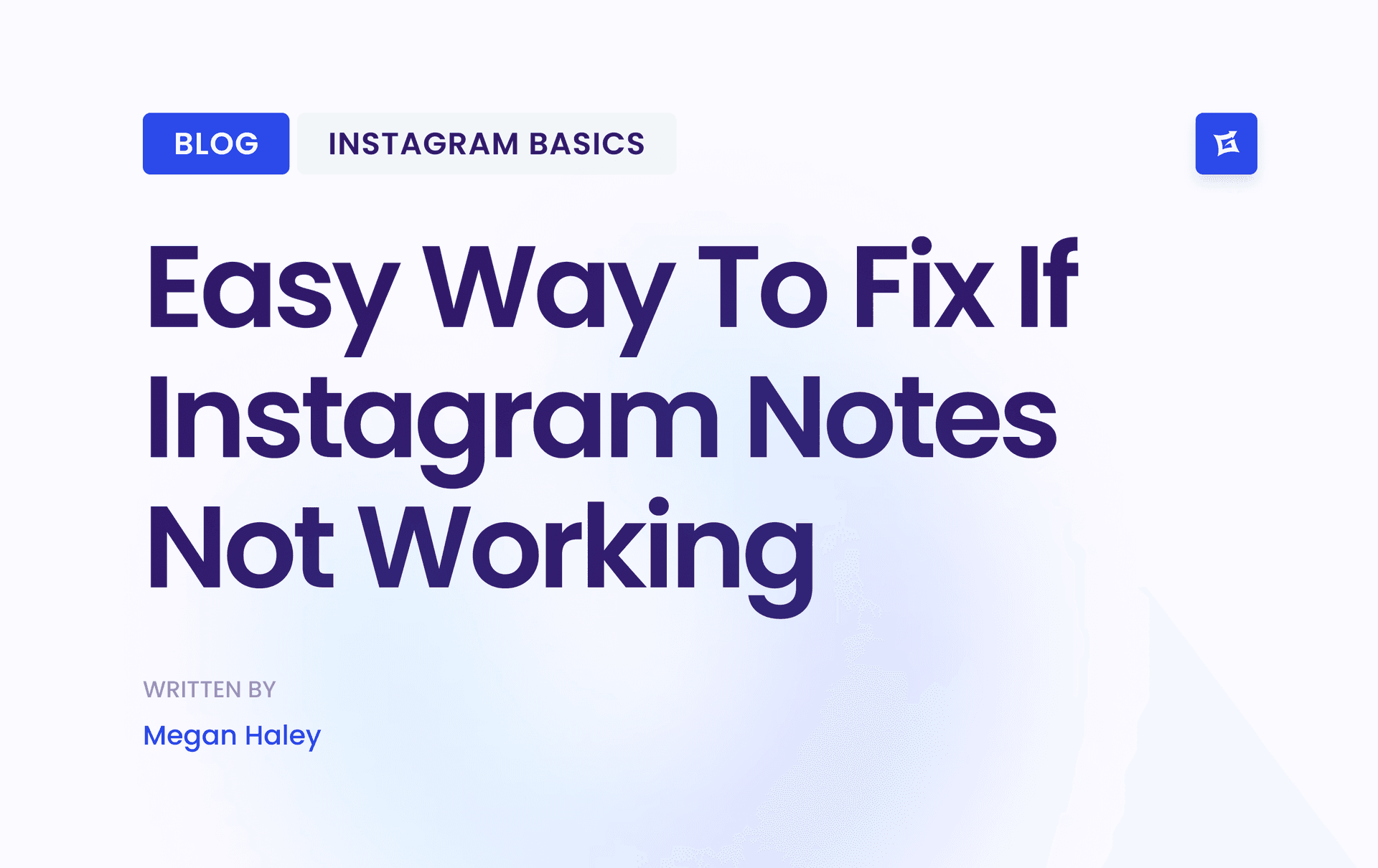
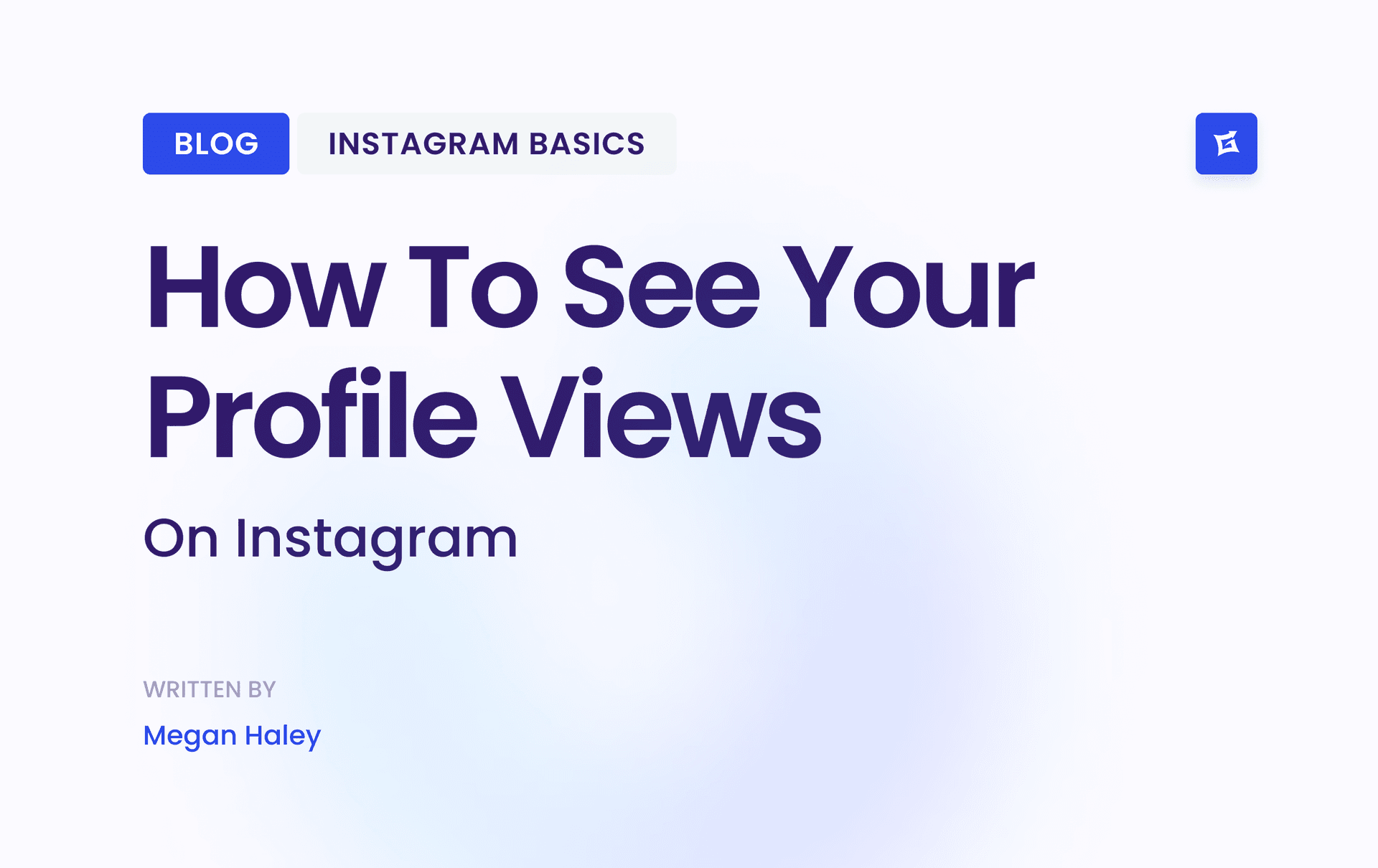
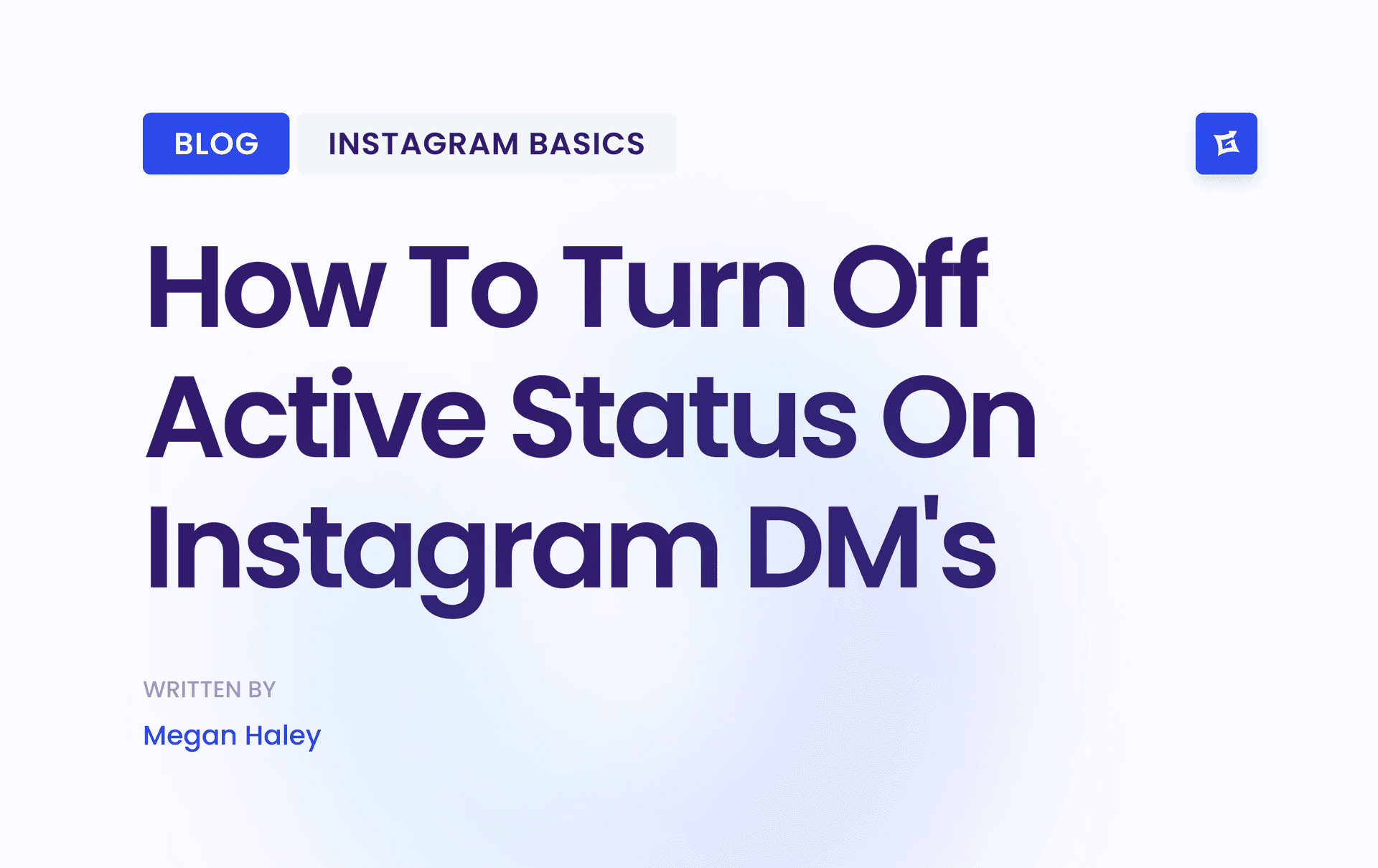
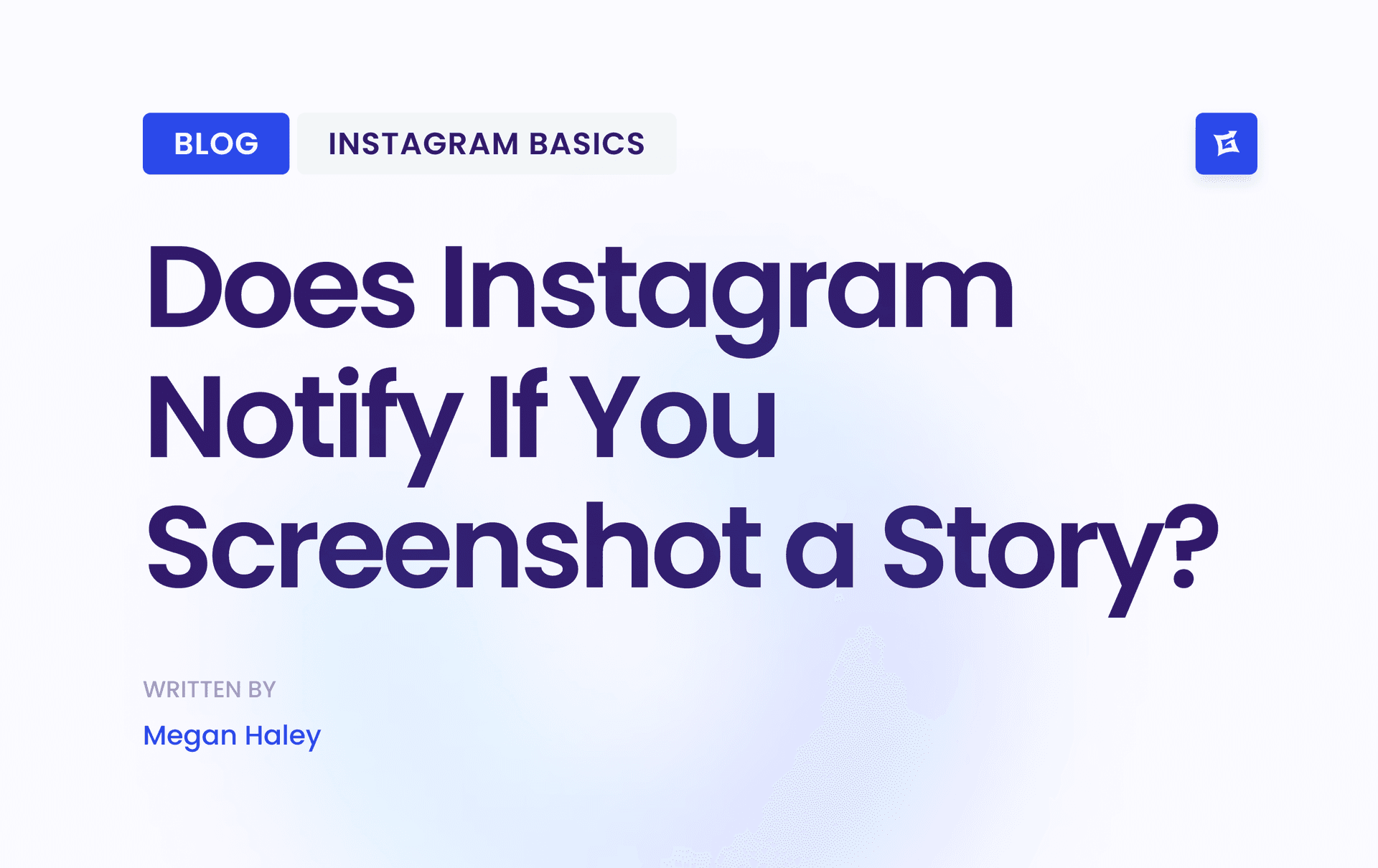



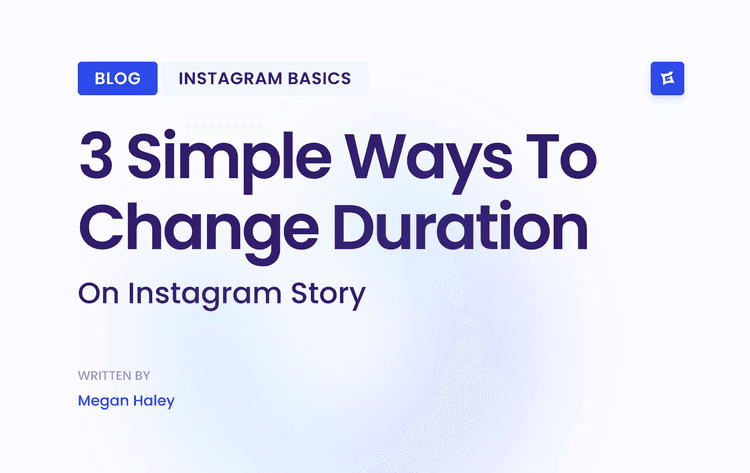
.png&w=750&q=75&dpl=dpl_9XSWKBjhcBN6v6b1SN7m3p1WWjfr)
